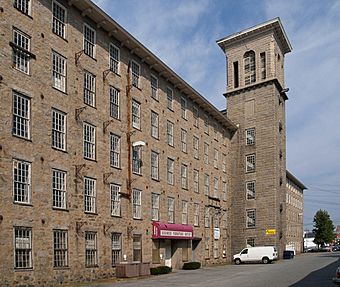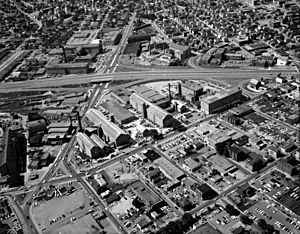Durfee Mills facts for kids
Quick facts for kids |
|
|
Durfee Mills
|
|

Mill No. 2
|
|
| Location | Fall River, Massachusetts |
|---|---|
| Built | 1866 |
| Architectural style | Italianate |
| MPS | Fall River MRA |
| NRHP reference No. | 83000664 |
| Added to NRHP | February 16, 1983 |
The Durfee Mills is a historic group of buildings in Fall River, Massachusetts. These buildings were once a very important textile mill complex. They are located at 359-479 Pleasant Street. The mills were built between 1866 and 1904. During this time, they were the largest and most beautiful mill complex in the city.
Today, the Durfee Mills are home to many shops and a restaurant. They are often called the Durfee-Union Mills because they are next to the Union Mills. The complex was added to the National Register of Historic Places in 1983. This means it is a special place worth protecting.
What are the Durfee Mills like?
The Durfee Mills are in the middle of Fall River. They sit on the north side of the Quequechan River. The area is shaped like a triangle. Pleasant Street is to the north, and Plymouth Avenue is to the southeast.
The complex has two main mill buildings. It also has many smaller buildings. All of them are made from local Fall River granite. The two main mills are 5 and a half stories tall. They face each other. Each has a tall, seven-story tower in the middle. These towers are built in the Italianate style.
Most of the smaller buildings are one or two stories high. Mill No. 3 is an exception. It is also 5 and a half stories tall. It is located at the corner of Pleasant and Plymouth. The buildings are known for their high-quality design. The main office building is especially well-designed.
When were the Durfee Mills built?
The Durfee Mills company started in 1866. They had $500,000 to begin. B.M.C. Durfee was the main owner and first president.
Mill No. 1 was built in 1866. It was used to make cotton cloth. The company was named after B.M.C. Durfee's father, Bradford. He helped start many of Fall River's early factories. The Durfee mill complex is the largest and most complete 19th-century mill that still exists in the city.
Mill No. 2 was added in 1871. Mill No. 3 was built in 1881. This made the factory much bigger. It could then use 109,360 spindles. The mills produced 23 million yards of cotton cloth each year. The company closed down in 1935. In 1968, a photographer named Jack E. Boucher took pictures of the site. This was part of the Historic American Buildings Survey.




